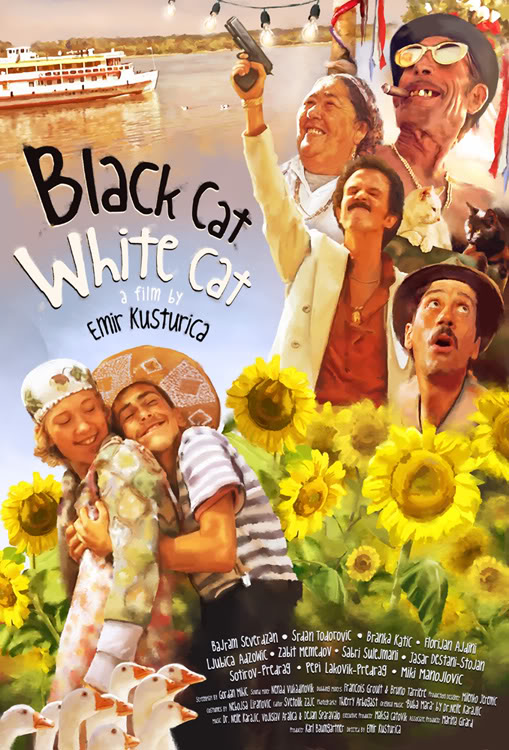Source: ia.media-imdb.com
Deutsch | Romanes | Rumänisch
The series „Romani Voices“ is giving people of the Roma community the opportunity to publish their opinions. The following text was written by Laura Moldovan. It is not a film review. It does not question the ability of Kusturica as a director. This text describes the perception of Laura Moldovan. It is her analysis of the „gypsies“ that Kusturica shows in his films and an analysis of what these constructed „gypsies“ and their caricatured world do with the perceptions of those who see these award-winning and highly acclaimed films.
The text is divided into 4 parts: an intro and 3 individual texts for different movies.
Part 1 Intro: Emir Kusturica and his „Gypsies“
Part 2: Opinion on „Time of the Gypsies“ (1989)
You are here: Part 3: Opinion on „Black cat, white cat“
Part 4: Opinion on „Blue Gipsy – All the invisible children“
Part 3 | „Black Cat, White Cat“ (1998)
by Laura Moldovan
After winning the Cannes award for “Best Director” for “Time of the Gypsies”, Emir Kusturica starts shooting “Arizona Dream” in New York. He was able to win over well-known actors such as Johnny Depp and Jerry Lewis for this production. This is the beginning of a difficult time in the biography of Kusturica.
The work on Arizona Dream strikes him hard – his father dies and his homeland Yugoslavia falls apart in the war. After the death of his father, Kusturica returns to ex-Yugoslavia and shoots his most courageous film „Underground“, in which he critically reflects on the history of his homeland in the last 50 years. „I’m not trying to say that I’m a genius, but “Underground” was the strongest attack on Milosevic,“ Kusturica said in an interview with The Guardian in 1999.
At this point in his career, Kusturica actually wanted to stop making films. He felt as he had fulfilled his „duty“ and sensed strong political pressure. Afterwards began the work on the film „Black cat, white cat”. Due to his negative experiences with the movie „Underground“, Emir Kusturica reconsiders his thematic (critical) orientation and his style and decides to change the tone of voice, to cover more shallow themes and fade his films away into „happy endings“.
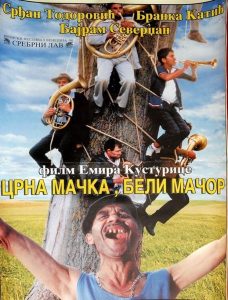
The original title of the movie „Black Cat, White Cat“ was „Acrobatic Music“. A scene that makes it easy to understand how this working title came about is the one showing a group of musicians tied to a tree as if it were the most normal thing in the world. This implies that the craziest things and situations are common in the life of the Roma. Kusturica allows himself to let his imagination run wild in this film and to come up with the most ridiculous and strange hypotheses about Roma and their culture.
The central topic of the film are weddings that take place despite of deaths in the family. The „happy ending“ comes with the resurrection of the old men – symbolizing the „survival of the Roma“ – and the victory of love. The main characters, Zare and Ida, are the only „normal“ people portrayed in the movie. On the cruise ship, they are relieved as they leave their relatives behind, illustrating Kusturica’s idea that only outside of the Roma community one can live a normal life.
„Happy ending“ | See YouTube Clip from Min 03:30
Strange, obscure and animally primitive
In Kusturica’s film, numerous bizarre characters appear: A bearded woman, an overweight mermaid, a green-haired bodyguard, the black obelisk, an overweight diva who can draw nails out of wood with her butt and countless others. Also, the magic can’t be missing from this movie. Due to a ritual made by the old one Zarije, he is only dead for one day in order to stop his nephew’s wedding. The grandson Zare also knows some magic tricks.
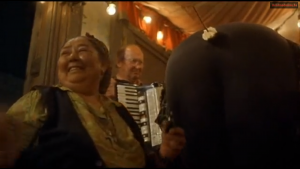
The fact that Kusturica is an admirer of Federico Fellini is also reflected in this film: he combines the daily life of the Roma with the circus and by that acquires the nickname „Fellini of the Balkans“. „I am proud to have discovered how this guy makes his films and that I can make mine in the same way. I use these little tricks, like a magician who sees a circus and goes to work in another. „(September 1999)
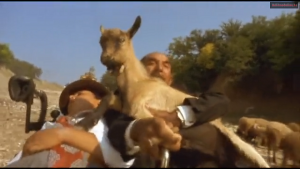
From the total chaos of this film – a circus in which the Roma coexist with animals – we conclude that Kusturica wanted to imply the similarity of the Roma to animals and their identification with them. In almost every scene in the film, animals are shown: dogs, goats, a peacock as a pet, cats as witnesses of a wedding, a pig eating a Trabant. Especially the geese can’t be missing as a recurring motif in Kusturica’s work. They are everywhere – in the yard, on the street, in the restaurant and even in the house. At the end of the film, they are even used instead of towels. Hereby Kusturica reminds of his favorite tale about Roma and geese.
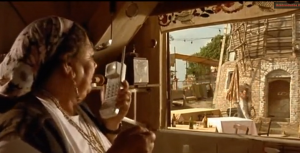
Kusturica wants to show the primitiveness of the Roma.
„They are medieval, but they have cellphones“,
he explains in an interview with the British newspaper The Guardian in 1999.
If it were for Emir Kusturica, we would probably still have to live in a golden cage for another hundred years, isolated from any technology. Like in the zoo, his audience could make fun of our suffering and our lives, just like in the circus.
A racist classic that makes it easy for the audience to put Roma into a convenient drawer of stereotypes only to take them out whenever they are needed.
Further artikels releated to Emir Kusturica:
Part 1 Intro: Emir Kusturica and his „Gypsies“
Part 2: Opinion on „Time of the Gypsies“ (1989)
You are here: Part 3: Opinion on „Black cat, white cat“
Part 4: Opinion on „Blue Gipsy – All the invisible children“
